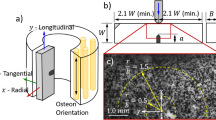Abstract
This paper is focused on specification of conditions at failure in bovine cortical bone. Both experimental and analytical studies are conducted. The experimental part includes a series of novel direct shear tests which examine the sensitivity of shear strength to the applied normal stress for different orientations of the sample microstructure. These experiments are supplemented by standard axial compression and tension tests in order to define and quantify a general form of failure criterion. The analytical part examines two different methodologies, viz. critical plane approach and microstructure tensor approach, for defining the anisotropic strength criterion. A procedure for identification of material parameters is outlined which is based on the results of the performed material tests.











Similar content being viewed by others
References
Boehler JP, Sawczuk A (1977) On yielding of oriented solids. Acta Mech 27:185–206
Cowin SC (1979) On the strength anlsotropy of bone and wood. J Appl Mech 46:832–838
Cowin SC (1986) Fabric dependence of an anisotropic strength criterion. Mech Mater 5:251–260
Cowin SC (1999) Bone poroelasticity. J Biomech 32:217–238
Das BM (2002) Soil mechanics laboratory manual, 6th edn. Oxford University Press, New York
Dong XN, Luo Q, Wang X (2013) Progressive post-yield behavior of human cortical bone in shear. Bone 53(1):1–5. https://doi.org/10.1016/j.bone.2012.11.029
Fenech CM, Keaveny TM (1999) A cellular solid criterion for predicting the axial-shear failure properties of bovine trabecular bone. J Biomech Eng 121:414–422
Gao H et al (2003) Materials become insensitive to flaws at nanoscale: lessons from nature. Proc Natl Acad Sci U S A 100(10):5597–5600
Garcia D, Zysset PK, Charlebois M, Curnier A (2009) A three-dimensional elastic plastic damage constitutive law for bone tissue. Biomech Model Mechanobiol 8:149–165
Hayes WC, Wright TM (1977) An empiricl strength theory for compact bone. Fracture 3:1173–1179
Hill R (1950) The mathematical theory of plasticity. Oxford University Press, London
Jäger I, Fratzl P (2000) Mineralized collagen fibrils: a mechanical model with a staggered arrangement of mineral particles. Biophys J 79(4):1737–1746
Keaveny TM et al (1997) Systematic and random errors in compression testing of trabecular bone. J Orthop Res 15(1):101–110
Martin RB, Burr DB, Sharkey NA, Fyhrie DP (2016) Skeletal tissue mechanics, 2nd edn. Springer, New York
Niebur GL et al (2000) High-resolution finite element models with tissue strength asymmetry accurately predict failure of trabecular Bone. J Biomech 33:1575–1583
Nyman JS, Leng H, Dong XN, Wang X (2009) Differences in the mechanical behavior of cortical bone between compression and tension when subjected to progressive loading. J Mech Behav Biomed Mater 2(6):613–619. https://doi.org/10.1016/j.jmbbm.2008.11.008
Odgaard A, Linde F (1991) The underestimation of Young’s modulus in compressive testing of cancellous bone specimens. J Biomech 24(8):691–698
Park HC, Lakes RS (1986) Cosserat micromechanics of human bone: strain redistribution by a hydration sensitive constituent. J Biomech Eng 19(5):385–397
Piekarski K (1973) Analysis of bone as a composite material. Int J Eng Sci 11(6):557–565
Pietruszczak S (2010) Fundamentals of plasticity in geomechanics. CRC Press, Boca Raton
Pietruszczak S, Gdela K (2010) Inelastic analysis of fracture propagation in distal radius. J Appl Mech 77:1–10
Pietruszczak S, Mroz Z (2001) On failure criteria for anisotropic cohesive-frictional materials. Int J Numer Anal Meth Geomech 25(5):509–524
Pietruszczak S, Inglis D, Pande GN (1999) A fabric-dependent fracture criterion for bone. J Biomech 32(10):1071–1079
Pistoia W et al (2002) Estimation of distal radius failure load with micro-finite element analysis models based on three-dimensional peripheral quantitative computed tomography images. Bone 30(6):842–848
Reilly DT, Burstein AH (1975) The elastic and ultimate properties of compact bone tissue. J Biomech 8(6):393–405
Rincón-Kohli L, Zysset PK (2009) Multi-axial mechanical properties of human trabecular bone. Biomech Model Mechanobiol 8(3):195–208
Saha S (1977) Longitudinal shear properties of human compact bone and its constituents, and the associated failure mechanisms. J Material Sci 12:1798–1806
Tsai SW, Wu EM (1971) A general theory of strength for anisotropic materials. J Compos Mater 5(1):58–80
Turner CH, Wang T, Burr DB (2001) Shear strength and fatigue properties of human cortical bone determined from pure shear tests. Calcif Tissue Int 69:373–378
Ulrich D, Rietbergen BV, Laib A, Rüegsegger P (1999) Load transfer analysis of the distal radius from in-vivo high resolution CT imaging. J Biomech 32:821–828
Winwood K et al (2006) Strain patterns during tensile, compressive, and shear fatigue of human cortical bone and implications for bone biomechanics. J Biomed Mater Res 79(2):289–297
Zdero R (2017) Experimental methods in orthopaedic biomechanics. Academic Press, London
Zioupos P, Gresle M, Winwood K (2007) Fatigue strength of human cortical bone: age, physical, and material heterogeneity effects. J Biomed Mater Res 86:627–636
Author information
Authors and Affiliations
Corresponding author
Additional information
Publisher's Note
Springer Nature remains neutral with regard to jurisdictional claims in published maps and institutional affiliations.
Rights and permissions
About this article
Cite this article
Mohammadi, H., Pietruszczak, S. Experimental and analytical study of anisotropic strength properties of bovine cortical bone. Biomech Model Mechanobiol 19, 1953–1963 (2020). https://doi.org/10.1007/s10237-020-01319-2
Received:
Accepted:
Published:
Issue Date:
DOI: https://doi.org/10.1007/s10237-020-01319-2




